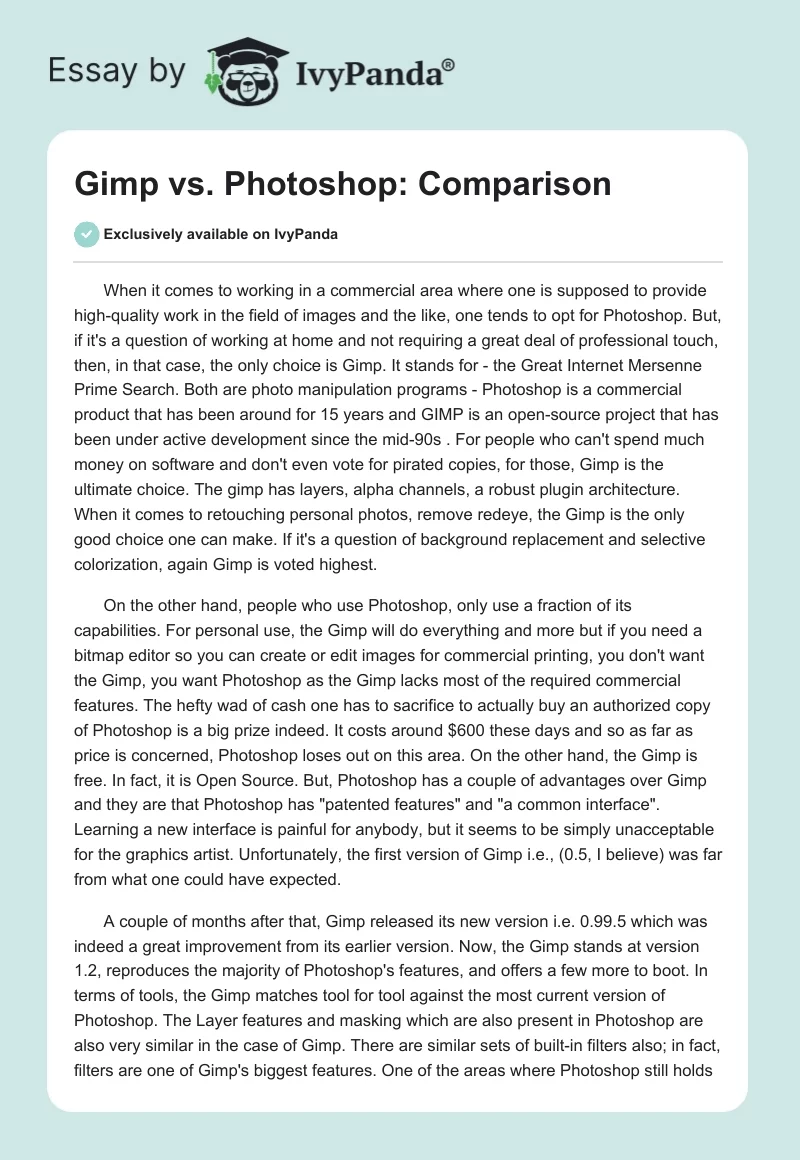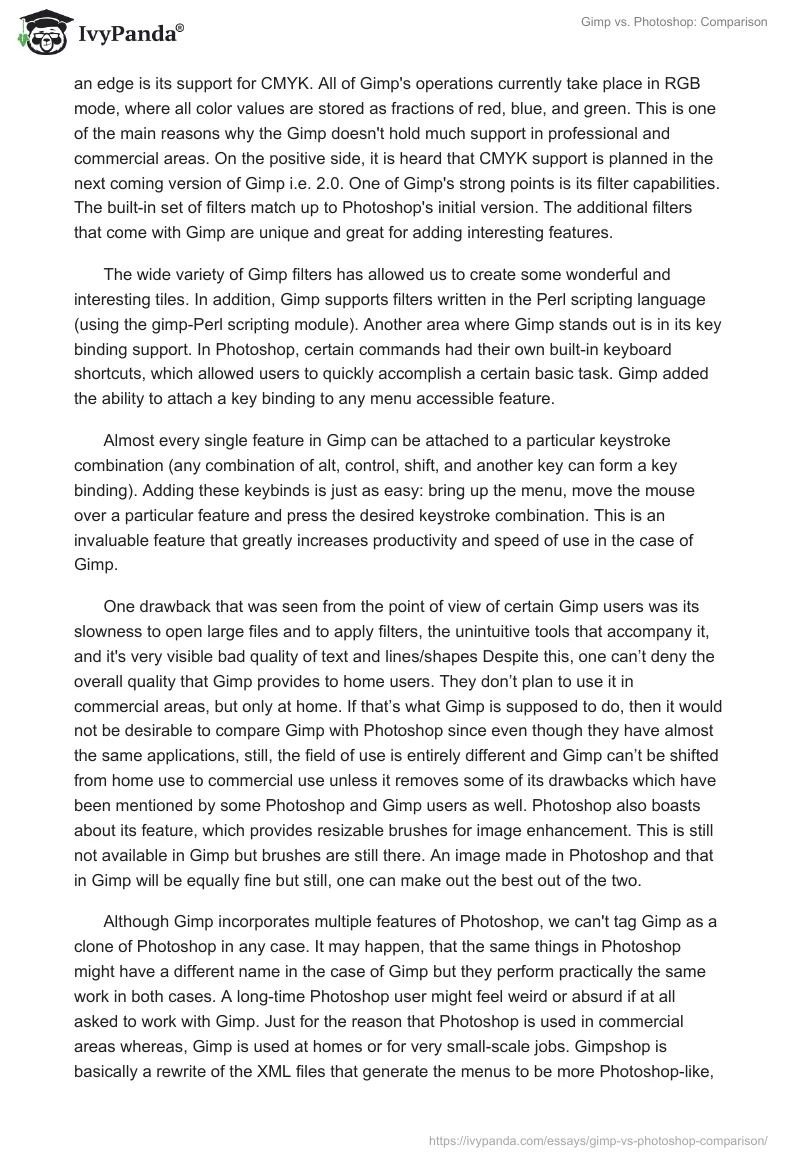When it comes to working in a commercial area where one is supposed to provide high-quality work in the field of images and the like, one tends to opt for Photoshop. But, if it’s a question of working at home and not requiring a great deal of professional touch, then, in that case, the only choice is Gimp. It stands for – the Great Internet Mersenne Prime Search. Both are photo manipulation programs – Photoshop is a commercial product that has been around for 15 years and GIMP is an open-source project that has been under active development since the mid-90s . For people who can’t spend much money on software and don’t even vote for pirated copies, for those, Gimp is the ultimate choice. The gimp has layers, alpha channels, a robust plugin architecture. When it comes to retouching personal photos, remove redeye, the Gimp is the only good choice one can make. If it’s a question of background replacement and selective colorization, again Gimp is voted highest.
On the other hand, people who use Photoshop, only use a fraction of its capabilities. For personal use, the Gimp will do everything and more but if you need a bitmap editor so you can create or edit images for commercial printing, you don’t want the Gimp, you want Photoshop as the Gimp lacks most of the required commercial features. The hefty wad of cash one has to sacrifice to actually buy an authorized copy of Photoshop is a big prize indeed. It costs around $600 these days and so as far as price is concerned, Photoshop loses out on this area. On the other hand, the Gimp is free. In fact, it is Open Source. But, Photoshop has a couple of advantages over Gimp and they are that Photoshop has “patented features” and “a common interface”. Learning a new interface is painful for anybody, but it seems to be simply unacceptable for the graphics artist. Unfortunately, the first version of Gimp i.e., (0.5, I believe) was far from what one could have expected.
A couple of months after that, Gimp released its new version i.e. 0.99.5 which was indeed a great improvement from its earlier version. Now, the Gimp stands at version 1.2, reproduces the majority of Photoshop’s features, and offers a few more to boot. In terms of tools, the Gimp matches tool for tool against the most current version of Photoshop. The Layer features and masking which are also present in Photoshop are also very similar in the case of Gimp. There are similar sets of built-in filters also; in fact, filters are one of Gimp’s biggest features. One of the areas where Photoshop still holds an edge is its support for CMYK. All of Gimp’s operations currently take place in RGB mode, where all color values are stored as fractions of red, blue, and green. This is one of the main reasons why the Gimp doesn’t hold much support in professional and commercial areas. On the positive side, it is heard that CMYK support is planned in the next coming version of Gimp i.e. 2.0. One of Gimp’s strong points is its filter capabilities. The built-in set of filters match up to Photoshop’s initial version. The additional filters that come with Gimp are unique and great for adding interesting features.
The wide variety of Gimp filters has allowed us to create some wonderful and interesting tiles. In addition, Gimp supports filters written in the Perl scripting language (using the gimp-Perl scripting module). Another area where Gimp stands out is in its key binding support. In Photoshop, certain commands had their own built-in keyboard shortcuts, which allowed users to quickly accomplish a certain basic task. Gimp added the ability to attach a key binding to any menu accessible feature.
Almost every single feature in Gimp can be attached to a particular keystroke combination (any combination of alt, control, shift, and another key can form a key binding). Adding these keybinds is just as easy: bring up the menu, move the mouse over a particular feature and press the desired keystroke combination. This is an invaluable feature that greatly increases productivity and speed of use in the case of Gimp.
One drawback that was seen from the point of view of certain Gimp users was its slowness to open large files and to apply filters, the unintuitive tools that accompany it, and it’s very visible bad quality of text and lines/shapes Despite this, one can’t deny the overall quality that Gimp provides to home users. They don’t plan to use it in commercial areas, but only at home. If that’s what Gimp is supposed to do, then it would not be desirable to compare Gimp with Photoshop since even though they have almost the same applications, still, the field of use is entirely different and Gimp can’t be shifted from home use to commercial use unless it removes some of its drawbacks which have been mentioned by some Photoshop and Gimp users as well. Photoshop also boasts about its feature, which provides resizable brushes for image enhancement. This is still not available in Gimp but brushes are still there. An image made in Photoshop and that in Gimp will be equally fine but still, one can make out the best out of the two.
Although Gimp incorporates multiple features of Photoshop, we can’t tag Gimp as a clone of Photoshop in any case. It may happen, that the same things in Photoshop might have a different name in the case of Gimp but they perform practically the same work in both cases. A long-time Photoshop user might feel weird or absurd if at all asked to work with Gimp. Just for the reason that Photoshop is used in commercial areas whereas, Gimp is used at homes or for very small-scale jobs. Gimpshop is basically a rewrite of the XML files that generate the menus to be more Photoshop-like, and a shortcut file to remap the shortcuts to match Photoshop and a script that puts all of the Gimp’s windows in one big window.
According to most online users, most of them have been working on Linux and with that, they prefer Gimp to Photoshop. Even those who have been using Photoshop for a long, are now also inclined towards Gimp since it’s for free as it is open-source and also because of the reason that they can see the source code for themselves which they find very helpful. The Vector-based shape/text support is only to be found in Photoshop and not in Gimp according to the latest verdict given by some of the Linux developers. This was the biggest productivity enhancement feature added in Photoshop. Whatever the case may be, but if these few additions are made in the Gimp, then the world will surely and finally have an open-source replacement for Photoshop. But to let that happen, much work has to be done in that field since developers and other users who have been working with Photoshop do not want any other replacement. But, those who have tried Gimp for once, have shown great appreciation for it saying that if certain features are made available then Gimp will not be limited to home use only. Instead, it can be also used in commercial environments.
Does GIMP have what it takes to dethrone Adobe Photoshop as the standard?
Right now, the answer is no.
Having used both Photoshop and Gimp extensively, one can honestly quote Gimp to be the better product. Also, the fact that it is a free open-source program is an even greater boon. In a nutshell, Photoshop is for linear thinkers, and Gimp is for lateral thinkers.
The truth is, they’re both winners when they’re used in the proper context. The Gimp just doesn’t have support in the areas that are necessary to make it useful in a commercial application. Bottom line, for website graphics and simple editing jobs it’s almost insane to spend the money to use Photoshop. And Gimp is likewise inadequate for the needs of a professional print shop or a commercial working environment.
But, in the end, Gimp is good for the average home user and Photoshop is advisable for commercial environments. Gimp is surely awaited to great-crash in the commercial fields too provided it fixes some of its features and gets ready for the neck-to-neck comparison with Photoshop.


